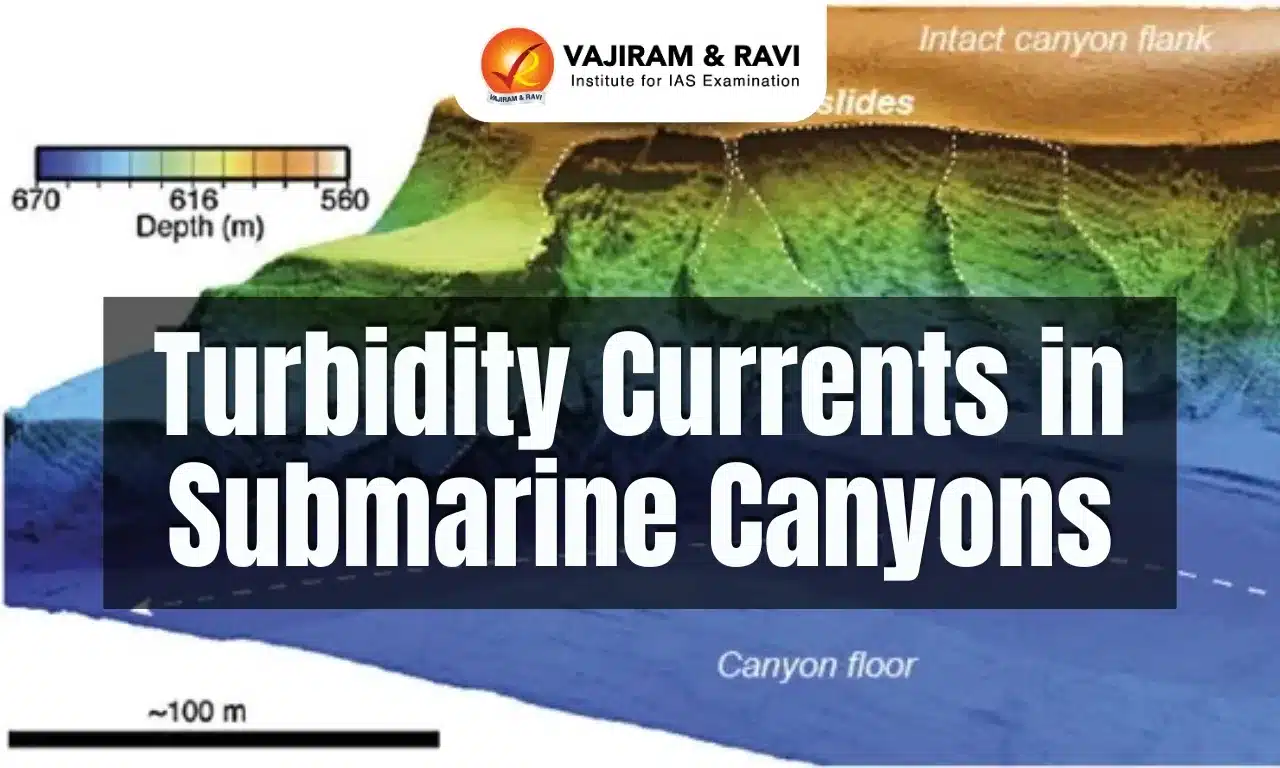Turbidity Currents in Submarine Canyons Latest News
A recent study published in ACS Environmental Science & Technology has provided the first direct evidence of turbidity currents transporting microplastics into the deep sea through submarine canyons, even in areas not fed by rivers (e.g., Whittard Canyon off Ireland).
What are Turbidity Currents?
- Turbidity currents are rapid, downslope flows of water heavily laden with sediments, increasing the water’s density.
- They function similarly to underwater avalanches, triggered by:
- Earthquakes
- Submarine landslides
- Slope failures and other geological disturbances
- Key Features of Turbidity Currents
- As turbidity increases, water becomes denser and less transparent.
- These flows erode the seafloor, forming and enlarging submarine canyons.
- They deposit sediment in graded layers, with coarser particles settling first and finer ones later.
- Aid in deep-sea sedimentation and shaping oceanic topography.
Submarine Canyons
- Submarine canyons are narrow, steep-sided underwater valleys found on continental slopes and rises, often extending from the continental shelf into the deep ocean.
- They are carved out mainly by erosional forces like turbidity currents, similar to how river canyons are formed on land.
- Globally, there are about 9,477 known submarine canyons, covering nearly 11% of continental slope areas.
- Canyons on active margins (tectonically active zones) tend to be steeper and shorter, while those on passive margins are more gradual.
- Their walls can be nearly vertical and are prone to collapse, adding sediment to turbidity flows.
Types of Submarine Canyons
- Bank: A flat-topped elevation on continental margins, formed by erosional and depositional processes, e.g., Dogger Bank in the North Sea.
- Shoal: A shallow area of sediment accumulation, often hazardous to navigation, and generally found at depths <10 meters at low tide.
- Reef: Built from calcareous skeletons of corals and algae; coral reefs are biodiversity hotspots and prominent in the Pacific Ocean, associated with guyots and seamounts.
Source: PHY
Last updated on December, 2025
→ Check out the latest UPSC Syllabus 2026 here.
→ Join Vajiram & Ravi’s Interview Guidance Programme for expert help to crack your final UPSC stage.
→ UPSC Mains Result 2025 is now out.
→ UPSC Notification 2026 is scheduled to be released on January 14, 2026.
→ UPSC Calendar 2026 is released on 15th May, 2025.
→ The UPSC Vacancy 2025 were released 1129, out of which 979 were for UPSC CSE and remaining 150 are for UPSC IFoS.
→ UPSC Prelims 2026 will be conducted on 24th May, 2026 & UPSC Mains 2026 will be conducted on 21st August 2026.
→ The UPSC Selection Process is of 3 stages-Prelims, Mains and Interview.
→ UPSC Result 2024 is released with latest UPSC Marksheet 2024. Check Now!
→ UPSC Prelims Result 2025 is out now for the CSE held on 25 May 2025.
→ UPSC Toppers List 2024 is released now. Shakti Dubey is UPSC AIR 1 2024 Topper.
→ UPSC Prelims Question Paper 2025 and Unofficial Prelims Answer Key 2025 are available now.
→ UPSC Mains Question Paper 2025 is out for Essay, GS 1, 2, 3 & GS 4.
→ UPSC Mains Indian Language Question Paper 2025 is now out.
→ UPSC Mains Optional Question Paper 2025 is now out.
→ Also check Best IAS Coaching in Delhi
Turbidity Currents in Submarine Canyons FAQs
Q1. What are turbidity currents?+
Q2. How do turbidity currents form submarine canyons?+
Q3. Where are major submarine canyons located?+
Tags: prelims pointers turbidity currents in submarine canyons upsc prelims current affairs

















